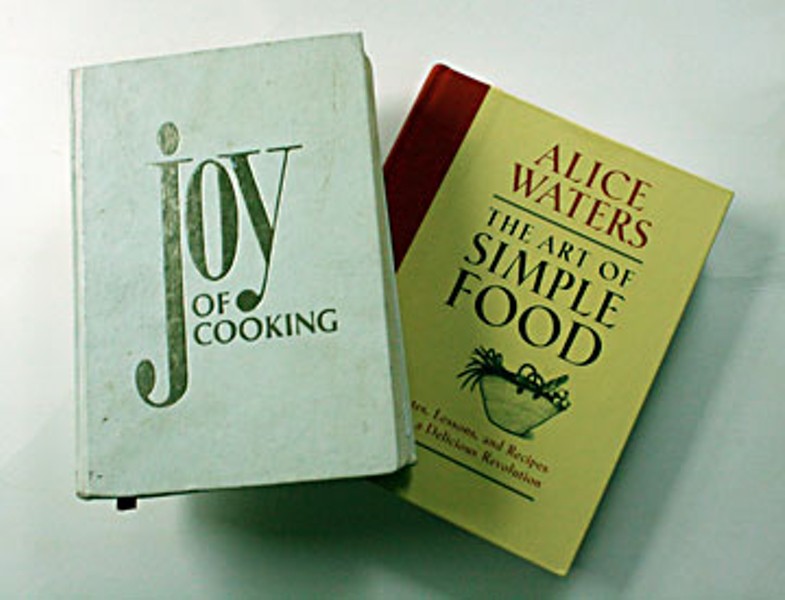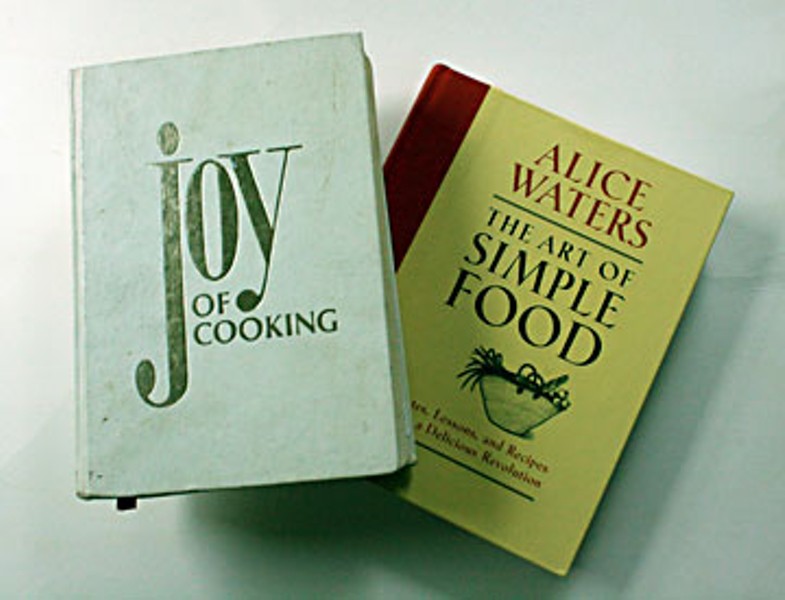Back in June, Journal publisher Judy Hodgson took a stroll down cookbook memory lane in this space. Her story about a meal she'd made for her husband's birthday touched on favorite recipes and their sources, in particular her worn-out copy of The Silver Palate Cookbook (held together with rubber bands) and The Playboy Gourmet, a retro sort of thing she's had since she married in 1966. Judy ended her piece with an invitation to "tell us the story of your favorite cookbook."
In an e-mailed response, Anne Harris of Anne's Pans offered a short list of classics: Jacques Pepin's La Technique ;La Methode , Mastering the Art of French Cooking by Julia Child and Simone Beck; and James Beard's Theory and Practice of Good Cooking . "But the cookbook that started it all for me was the tried and true Fannie Farmer Cookbook ," Harris concluded. "It got me through college and then some. Marion Cunningham has written the updated version, which is thorough, but my old battered paperback was a good friend."
Even more telling was a bundle dropped off at the Journal office from local artist Francis Boettcher, whose bold oil paintings and functional pottery often use food as a subject. (I have one of her pear paintings in my kitchen.) Francis' package, wrapped in a grocery bag, included three dog-eared cookbooks from her past: There was Betty Crocker's Picture Cook Book , a binder of recipes with an inscription that suggested it may have been a wedding present, a copy of The Tassajara Bread Book (a hippie baker's classic from the '70s) and a seriously battered copy of The Joy of Cooking circa 1962.
The Joy had obviously been used the most. The original front cover was gone, replaced with a piece of artist's board held in place with strips of silver duct tape. The first few pages were filled with handwritten recipes for cookies and cakes and a note about bacon-wrapped chicken livers. Stuck inside were clippings from newspapers and magazines with more recipes, and a letter from a friend with instructions on making something called "Galumphs," a type of cabbage roll cooked in tomato soup. It was clear this book was an old friend.
My own collection of cookbooks is large, the result of a couple of decades working as a chef. Among them are almost all of the cookbooks mentioned above. (I don't have The Playboy Gourmet and I have a different Betty Crocker.) I actually own far too many for the bookshelf in our dining room, thus there are a couple of boxes stashed in the attic and more in storage. Among the treasures: Larousse Gastronomique and The Escoffier Cook Book (both gifts from my friend Sean, a fellow chef); a paperback copy of Elizabeth David's Mediterranean Food ; and my British grandmum's tattered, spineless copy of Mrs. Beeton's Every Day Cookery , a book from 1907. The Mrs. Beeton's is based on her earlier Book of Household Management, a precursor to the Fannie Farmer book mentioned above (officially that one's The Boston Cooking-School Cookbook) and in some ways to The Joy of Cooking.
The Mrs. Beeton'sis an heirloom, and is fascinating for anachronistic recipes — blackbird pie, for example — but it's not really something I use as an everyday cookbook. When I think about it, The Joy of Cooking is the book I use most. I've recently referred to it to figure out the cooking timing per pound for a beef roast and to get a basic idea of how to make scalloped potatoes (that's where the built-in ribbon markers are). Ours is a hardback 1975 edition picked up at a yard sale to replace a paperback we received as a wedding gift.
A little history: The originalJoy of Cooking was self-published by Irma Rombauer in 1931. A Midwestern lawyer's wife, she'd compiled recipes for a cooking class for a St. Louis Unitarian women's circle. After her husband committed suicide during the Great Depression, she expanded on the collection and put a cookbook together, both as personal therapy and as a means to pay the bills. Her daughter Marion Rombauer Becker drew illustrations. It was more than a collection of recipes: Irma used a personal tone writing about cooking and entertaining, approaching it as if she was a friend offering advice. True to the books' title, she imparts a philosophy of food preparation that elevates it from chore to joy.
Bobbs-Merrill Publishers picked the book up and took it national in 1936. It's gone through seven editions and sold 18 million copies since. The cookbook has always been a family affair, at least to some extent. Marion Becker took the helm after her mother died in 1962. But since that 1936 edition the publisher has owned the rights to the title, a fact that the family has learned the hard way a couple of times. The 1962 revised edition did not pass muster with the Beckers and was rife with errors that had to be corrected in subsequent revisions of the revision.
Marion Becker died after completing a 1975 update. That version was fundamentally unchanged until 1997, when a controversial "All New, All Purpose" Joy of Cooking was published by Simon and Schuster/Scribner, who had acquired the rights. As noted on the official "Joy Kitchen" website (thejoykitchen.com), "Not since the unauthorized edition in 1962 has the publisher exercised such control over an edition."
Marion's son Ethan worked on the book, but reportedly exerted little influence over the Scribner editor, Maria Guarnaschelli, who replaced parts by Irma and Marion with writings by a team of modern chefs. From the family's perspective, "The end product lacked the whimsical asides and casual, friendly voice for which Joy is famous ... and disappointed loyal Joy fans."
When 2006 rolled around and it was time for a new edition marking the 75th anniversary of the original publication, Ethan convinced Scribner that they should scrap the 1997 version and instead update the popular 1975 edition, bringing back the Joy-ful voices of Irma and Marion.
Over the holidays I added a couple of volumes to my cookbook collection. My friend Dianne (a really great cook) gave me a copy of The Silver Spoon , a massive Italian bestseller aka Il Cucchiaio d'argento. With a couple of thousand recipes spread over more than 1,200 pages, it's a lot to absorb. The British publisher Phaidon translated it for a lavishly illustrated American edition. I've read that the translation is not perfect, that mistakes have been inserted, but I haven't cooked anything from it yet, so I don't really know.
The second new cookbook is something I bought when we went to Powell's Books on a trip to Portland: The Art of Simple Food , by the extremely influential chef Alice Waters. In many ways this is Waters' 21st century version of Every Day Cookery or The Joy of Cooking. In the introduction she describes the book as "for everyone who wants to learn to cook, or to become a better cook." Although there's no attempt to be comprehensive and include thousands of recipes, the aim is to craft a course on the principals, methods and tools required for day-to-day cooking, and to offer an essential collection of basic recipes and their variations.
At the same time the book is a manifesto of sorts. Waters begins by talking about something she calls her "delicious revolution." She goes on to offer what could be described as the Nine Commandments of Simple Food:
• Eat locally and sustainably.
• Eat seasonally.
• Shop at farmers' markets.
• Plant a garden.
• Conserve, compost and recycle.
• Cook simply, engaging all your senses.
• Cook together.
• Eat together.
• Remember food is precious.
I know some will find Waters' commands unnecessarily didactic. Even the Journal's garden columnist Amy Stewart has gone on record as being tired of the "word of the year," locavore, and of being told to eat local. (You'll find a link to Amy's rant on All Things Considered on the North Coast Journal Blogthing post "Locavorophobia.")
And not everyone is ready for a cookbook that couples simple recipes with an attempt to create a new attitude towards the way we eat. Michael Pollan's new book, In Defense of Food: An Eater's Manifesto , just now hit the shelves of the nation's bookstores. While I haven't picked it up yet, my guess is it will go hand in hand with Waters' Art of Simple Food.
Can a book change the way we live? That's a weighty mission, but it's happened before, and Waters does not hesitate to describe herself as a revolutionary. My prediction: More than one young couple will get a copy of Waters' cookbook for a wedding present along with the blenders and cookware sets. It may not change their lives, but at least they'll share some good meals along the way.


Comments